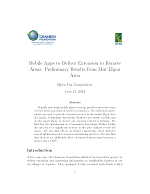Fonkoze PPI Mini Case Study
 Since 2008, Fonkoze has been using PPI and food security data to monitor and evaluate the progress of clients participating in its targeted programs for hurricane relief. Fonkoze is now also using it for earthquake recovery efforts.
Since 2008, Fonkoze has been using PPI and food security data to monitor and evaluate the progress of clients participating in its targeted programs for hurricane relief. Fonkoze is now also using it for earthquake recovery efforts.


 This case study shows how PT Ruma, the first technology-for-development initiative to use the PPI, applied its findings to guide twin goals to reach more poor women with its mobile phone business microfranchises and to affirm its social accountability to shareholders.
This case study shows how PT Ruma, the first technology-for-development initiative to use the PPI, applied its findings to guide twin goals to reach more poor women with its mobile phone business microfranchises and to affirm its social accountability to shareholders. The case study explores how Grameen Koota, a leading socially-focused microfinance institution in India, is using the PPI to measure and track its clients’ movement out of poverty.
The case study explores how Grameen Koota, a leading socially-focused microfinance institution in India, is using the PPI to measure and track its clients’ movement out of poverty. In 2009, the Grameen Foundation selected CARD Bank, a Philippine microfinance institution (MFI) with over 580,000 clients, to participate in its Microsavings Initiative. This case study describes how CARD Bank has used the PPI to identify opportunities for product cross-selling.
In 2009, the Grameen Foundation selected CARD Bank, a Philippine microfinance institution (MFI) with over 580,000 clients, to participate in its Microsavings Initiative. This case study describes how CARD Bank has used the PPI to identify opportunities for product cross-selling. This case study describes the role of Grameen Foundation in developing training programs for Oikocredit partner MFIs in the Philippines and Peru.
This case study describes the role of Grameen Foundation in developing training programs for Oikocredit partner MFIs in the Philippines and Peru. This case study describes how NWTF, an early adopter of the PPI, piloted and implemented the new poverty assessment tool. It outlines the experiences of NWTF management and staff as they made key decisions related to testing and data analysis.
This case study describes how NWTF, an early adopter of the PPI, piloted and implemented the new poverty assessment tool. It outlines the experiences of NWTF management and staff as they made key decisions related to testing and data analysis. This study finds that the introduction of a Community Knowledge Worker within the area led to a signicant increase in the price farmers receive for maize. It also finds effects on farmer's knowledge, their attitudes toward information and extension and farming practices.
This study finds that the introduction of a Community Knowledge Worker within the area led to a signicant increase in the price farmers receive for maize. It also finds effects on farmer's knowledge, their attitudes toward information and extension and farming practices. This document explains our MOTECH project in Ghana and highlights key lessons learned by the project team as the system was being designed, developed and implemented. Although MOTECH is viewed as a “technology project,” the majority of the lessons learned are around operational issues, cultural components and operating with partners to make the project successful.
This document explains our MOTECH project in Ghana and highlights key lessons learned by the project team as the system was being designed, developed and implemented. Although MOTECH is viewed as a “technology project,” the majority of the lessons learned are around operational issues, cultural components and operating with partners to make the project successful. In this study, Grameen Foundation reviews microfinance institutions' (MFIs) experiences with mobile financial services and assesses the challenges and opportunities faced during implementation.
In this study, Grameen Foundation reviews microfinance institutions' (MFIs) experiences with mobile financial services and assesses the challenges and opportunities faced during implementation. The mobile phone is gaining widespread popularity as a means to bridge the “last mile” – to bring information and financial services to people without ready access to them. To get a better picture of how to best deliver mobile services, we conducted a case study with our partner, Cashpor Microcredit, based in Varanasi, India.
The mobile phone is gaining widespread popularity as a means to bridge the “last mile” – to bring information and financial services to people without ready access to them. To get a better picture of how to best deliver mobile services, we conducted a case study with our partner, Cashpor Microcredit, based in Varanasi, India.